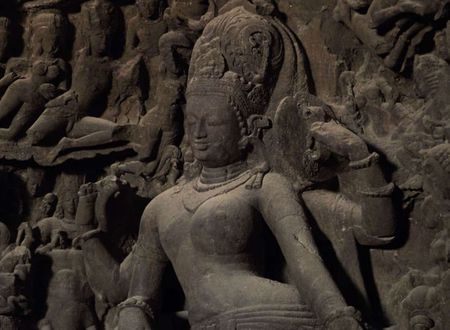Goswami Tulsidasa writes in a certain legend in the Ramayana, an ascetic tells King Pratapbhanu upon the latter being amazed to see the occult powers of the adept:
Jani ācaraju karu mana māhi, suta tapa tē duralabha kachu nāhi. Tapabala tē jaga srjayi bidhātā, tapabala biṣṇu bhayē paritrātā. Tapabala sambhu karahi sanhārā, tapa tē agama nahi kachu sansārā. (Tulsi Ramayana, 1.162.1-2) Do not be surprised dear. Nothing is impossible with sadhana. It is with tapas alone that Brahma creates, Vishnu protects, and Shiva destroys. With penance, nothing in the three worlds is unattainable.
There are no quick fixes. Success in sadhana, the practice of self-transformation, is proportionate to the amount, quality, and consistency of effort put in. Great persistence is rewarded by extraordinary rewards.
In the aphorisms of Patanjali, he states that yoga is the practice of erasing your psychic imprints in Yōgaścittavrttinirōdhaḥ (Patanjali Yoga Sutras, 1.2) and he starts by saying atha yōgānuśāsanam (ibid, 1.1), “Now begins the discipline of yoga.” So, sādhāna is about adhering to the specified discipline; in a strict and careful manner until you attain your goal.
The yoga of self-transformation helps the practitioner to turn inward completely. Besides discipline, success in the actual sadhana depends on four key aspects: the sadhaka (aspirant), the siddha (master), the sadhya (goal) and sadhan (resources). The absence of any one of the four puts the whole practice on shaky ground. The palace of stones turns into a sand castle — fragile and temporary. It is worthwhile to understand the fundamentals of sadhana before delving into the actual practice. As follows:
1. The Sadhaka — The Seeker
The seeker is the sadhaka (साधक), the practitioner, who is committed to the path. He has realized the futility of material pursuits and naturally builds upon on the flourishing indifference (vairāgya) towards material attainments. He has understood that irrespective of the degree of success in worldly pursuits, they continue to be temporary. Further that, they, ineluctably, bring greater misery and fear. In the material world, the first fear is of failure when you are working towards creating something. If you succeed, the second fear is of losing your acquisition.
Protecting and holding on to the achievement keeps one on one’s toes. A seeker is the one who has decided to go beyond his fears and cross the ocean of his tendencies of the mind to reach the peaceful shore of inner peace and his true nature. There is no practice without the practitioner. The seeker forms the main pillar of the actual practice.
The seeker must be committed to two things above everything else: practice and dispassion.
Krishna says to Arjuna: Asanśayaṁ mahābāhō manō durnigrahaṁ calaṁ Abhyāsēna tu kauntēya vairāgyēṇa ca gr̥hītā.(Bhagavad Gita, 6.35) O Warrior! Doubtlessly, it is an extraordinary feat to conquer one’s mind. But, Arjuna! With practice and dispassion it is possible.
If the aspirant continues to find joy in materialistic or sensory pursuits of the external world, his journey to discover the inner one will be a drag. His efforts are going to be diluted. Dispassion comes as a result of reflecting on the temporary, illusory, and selfish nature of the material world as well as with the conscious effort of letting go (tyāga) of all that binds you. A genuine seeker has both.
If you can enjoy with no attachments, you have learned the art of living. It is not the joy itself but the attachment to such joy that binds one. Detachment comes from staying even under all circumstances. And evenness comes from an ever-present mind that helps you remember to stay the course. An alert mind, in turn, is a natural outcome of good meditation.
2. The Siddha —The Guru
The guru is the siddha (सिद्ध), the adept, who has already been there and done that. His role is to guide the seeker and help such a practitioner get across the hurdles. For eons, all systems of various yoga and the practices thereof have been passed on from a guru to disciple. To the highly committed seeker, finding and meeting his guru becomes an automatic act — almost like a preordained rendezvous. There is no need to go out in search of a guru.
Once you start the actual practice and stay on course firmly, Nature will arrange for your guru to come into your life. And until such time, even if you do meet the right guru, you will stay oblivious and unaware. Do not be hasty in selecting a guru. A guru is not a formality or a transaction of convenience. He is not an item you can just tick off.
The right guru can dispel your doubts, help you cross hurdles, and assist you in spiritual attainment faster and better than you on your own.
abhavētsaṅgayuktānāṁ tathā viśvāsnāmapi, gurupūjāvihinānāṁ tathā ca bahusaṅginām. Mithyāvādaratānāṁ tathā ca niṣṭhurabhāṣiṇām, gurusantōṣahinānāṁ na sid'dhiḥ syātkadācana. (Shiva Samhita, 3.17-18) The one who is attached to the material world, lacks faith, has no devotion towards his guru, rejoices in socializing, lies, speaks harshly, disregards guru's needs is unlikely to attain his spiritual goal.
A guru is not indispensable. I am deviating from the word of the scriptures with the previous statement; I am doing so based on my personal experience and observations. However, the right guru can certainly accelerate your journey. If you lack the burning desire, even God cannot help you attain your goal, let alone any guru in a human body. Just like a competent spiritual master can bring out the best in his disciple, a devoted disciple can also get the best from his guru.
Devotion, faith, honesty, and service are the ingredients for the right recipe. If your guru wants material things from you or if his giving time to you is dependent on how much you have to offer, forget that guru like a bad dream. How can the one who has not risen from desires himself instruct you on dispassion?
Guru banāyō jāni kē, pāni pīyō chāni kē, Drink water after filtering and make a guru after examining, a famous saying in the Nath sect. It has traveled verbally so I am unsure of its origin.
3. The Sadhya — The Goal
The third important pillar is the goal, sadhya (साध्य). It is pivotal to know your target. The yoga of self-transformation has many milestones that are aimed at guiding the seeker. If you do not know your goal, an attainment of anything will mean everything, or achieving everything may mean nothing. The course of action can only be charted if you know the destination.
Some may want occult powers, others, Samadhi, and many others may just want a better way of living. Anything is possible with the right practice. For a yogi, the goal may be a yogic trance. For the mantrin, the goal may be to invoke the latent power of the mantra. For the worldly, it may just be the acquisition of material wealth. For the ill, it may be to regain physical health. Whatever your goal may be, it is important to have one and carry out the practices accordingly.
I would like to quote a verse from a vaishanava tantric text:
Āradhāitō yadi haristapasā tataḥ kim Nārādhitō yadi haristapasā tataḥ kim. Antarvahiryadi haristapasā tataḥ kim Nāntarvahiryadi haristapasā tataḥ kim.(Nārada Pancrātra, 1.2.6) If your worship leads to Śrī Hari, what good is any penance; of what use is any austerity if you are not lead to Śrī Hari. If you worship him within and without, tapas is no longer important; if you do not worship him within and without, how can tapas be of any importance.
Read the above statement multiple times to let its profundity sink in and settle. Although uttered with a devotional sentiment, the aforesaid statement highlights the essence of all sadhana. That is: one must never lose sight of one’s goal on the path of sadhana. If you are treading any path that does not lead you to your goal, why waste your time on such a path? The rules, discipline, framework, and philosophy are only a means to an end. Your sadhana is to attain your sadhya. Once done, you are ready to define your own rules because when you are delivered, you are free. Free of everything.
It is important to follow the rules initially. Just like if you are driving on the highway, for your own safety and that of others, you follow the traffic rules. But once home, you no longer walk in lanes or indicate before turning. Very much like the lane markings are there to guide you, any discipline on the spiritual path is to assist you. If you turn your discipline into a ritual losing sight of the ultimate, your path will become a conglomerate of dry practices devoid of bliss and joy.
4. Sadhan — The Resources
The last and certainly not the least aspect is sadhan (साधन), resources. It is not possible to do the practice without support. By resources, I do not mean that you require substantial financial capital. For the initial stages, you can start the practices sitting in your home.
As you progress, your circumstances should allow you to do almost like a ‘meditation getaway’ of a week, ten days, or month once or twice a year at the minimum. Your routine during that getaway will be intensive meditation.
Further, with continued advancement, a ‘quieter’ place will be required for intensive practices of silence and solitude. You are not going to see serious results without intense practice.
You need not worry about any of the above at this stage. To begin with, you require a burning desire, commitment to the practice, purity of moral, spiritual, and yogic discipline. For a genuine seeker, Providence arranges for everything as the need arises. I say this from my first-hand experience.
Enjoy the journey!
Peace.
Swami
Editorial Note
As you’ve read, the sadhak, the siddha, the sadhya and the sadhan – these are the four cornerstones of sadhana, perhaps even stages of sadhana. The meaning and success of any sadhana practice depends on these four aspects.
Course
Art of Meditation
Free yourself from suffering and live life to the fullest. Learn the yogic technique of meditation in 4 days (and master it over a lifetime)
The following FAQs speak about the other aspects of sadhana, including spirituality as a way of life, Kundalini and the results of intense sadhana.
Ultimately, no matter the path, there’s only one way to make your sadhana a success – disciplined persistence. What are the extraordinary rewards you will gain, in the process?
You shed your old tendencies of negativity like a snake sheds its old skin. You begin to gain control over yourself.
Om Swami
1. What is the way for spiritual growth for a family man?
In my conversations with scores of people, many have asked about the starting point, the stages of sadhana and feasibility of self-realization for householders.
A burning desire to experience your true nature and an unwavering commitment to your chosen path are the prerequisites.
Give yourself a clean slate with resolve and do not be too hard on yourself. Regardless of all that has been done in the past, if you want to go through self-purification leading to self-transformation, you can do it.
Whether it is through the sadhana of meditation or the sadhana of compassion, it is doable.
Continue reading about the first step in meditation for a householder.
2. Is a guru really necessary for spiritual advancement?

Om Swami expresses his view and answers the question on the presence of a Guru in a person’s life. Watch the video with english subtitles to learn if the presence of a Guru is necessary in life.
Spiritual and religious texts expounding the Eastern thought are full of master-disciple stories of surrender and obedience. Many people who visit the ashram and many who write to me are inquisitive about the role of a guru on one’s path, they ask me if it is necessary to surrender.
Furthermore, a lot many admit having troubles in exercising complete surrender to any guru.
There are thousands of quotes in various texts that lay emphasis on the importance of having the right guru. Is it truly that crucial? The answer is it depends on what you are after.
If you simply need a teacher who can point you in the right direction based on scriptures and books, there is no dearth of such people. However, if you need someone who can demonstrate any bit of direct experience, someone in whose presence you feel safe, secure, loved, peaceful, you have little choice.
Be it guidance in leading a kinder and more compassionate life or guidance in specific types of sadhana, a real guru will give you exactly what you need.
Continue reading about surrendering to a guru.
3. What happens when your kundalini is awakened?

Om Swami says that the beautiful thing about kundalini is that you can awaken this energy without having to believe in God or any supernatural power. All that is needed is persistence and discipline. The first thing is the knot of creation which sits at the root chakra. This is not the natural abode of kundalini but has slipped because she is drunk. When kundalini awakened and it moved up the Sahasrara there was a flash like lightning and there it drank the nectar and slipped as it was a heady experience. Watch the video to learn about Kundalini Awakening.
The practice of Kundalini awakening, also known as Shakti Chalana, is one of the most ancient yogic practices. There are many hatha yoga practices that have been associated with Kundalini sadhana. Notably, khechari mudra, bandhas (locks), pranayama, hasta mudras (hand locks), and some yoga asanas.
However, I won’t be covering these.
Instead, my focus will be to expose you to the method of pure kundalini awakening with seed syllables and colors and once you’ve traversed the path of Kundalini sadhana for at least about a year, you will be ready to gain from the practices above.
Prolonged meditation done over a period of time automatically pierces the chakras as Kundalini meets Sahasrara. You can somewhat hasten the process by meditating correctly on your chakras.
Continue reading about the Kundalini meditation retreat that will teach you to meditate correctly on your chakras. I also elaborate on the meaning of Kundalini and narrate my first-hand experiences on this path.
4. How does one do the Navratri Sadhana?
The Navratri Sadhana is one of the types of sadhana used to invoke the Divine Mother.
To that end, I am mighty pleased to share the extremely beautiful and powerful Nav-Durga Sadhana with you. If you feel in your heart any devotion or reverence for Mother Divine or the feminine aspect of creation then you may enjoy and benefit from this sadhana a great deal.
There are two parts of this sadhana: morning and evening. You will need to set aside about thirty minutes in the morning and approximately forty-five minutes in the evening (anytime during or after sunset is okay) for the nine days of Navratri.
Continue reading about the details of the Nav-Durga Sadhana.
5. What is an example of success in tantra sadhana?
Today, I bring to you the most important video – Vision of the Goddess.
This is not just any video. It is not a discourse. This is my living experience, the one I breathe and live every moment of my life.
Every single word uttered in the video is pure truth; truth as I saw, as I experienced and as I felt. This video contains my first-hand account of what all happened when I got my first comprehensive, living, and unambiguous vision of the goddess, the Divine Mother – the result of intense tantra sadhana in solitude.
I recommend that you watch it when you have an uninterrupted thirty minutes to spare. Sit in solitude, put your headphones on, turn off your mobile, remove all distractions, and watch this video. I think you will get something out of it, especially if you believe in the notion of God.

Timeline:
- 0:01: Vision of the Goddess
A GOOD STORY
There were four members in a household. Everybody, Somebody, Anybody and Nobody. A bill was overdue. Everybody thought Somebody would do it. Anybody could have done it but Nobody did it.
Don't leave empty-handed, consider contributing.It's a good thing to do today.









Comments & Discussion
31 COMMENTS
Please login to read members' comments and participate in the discussion.